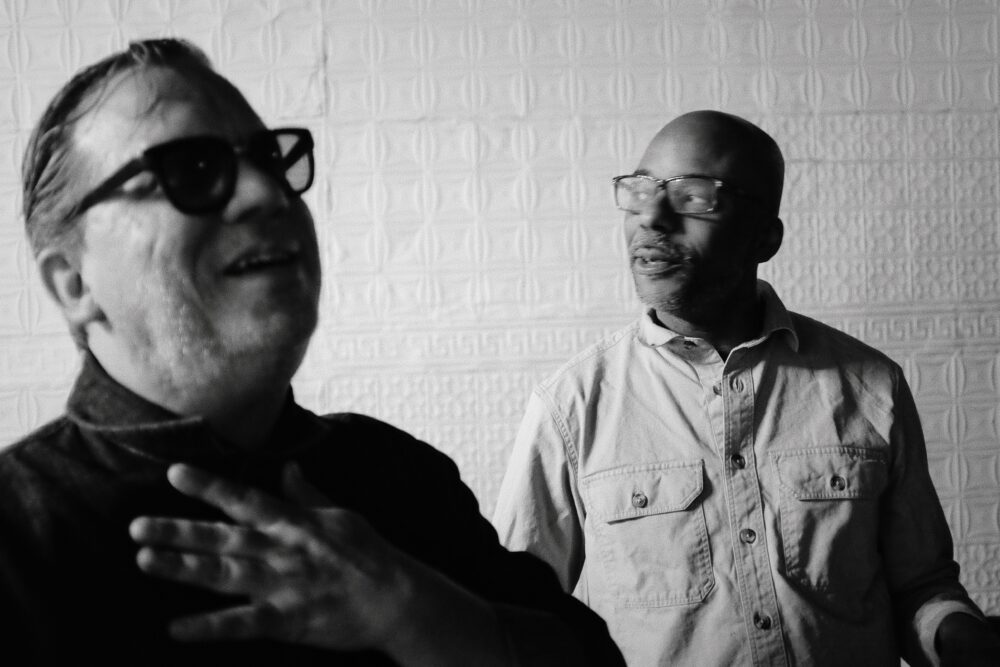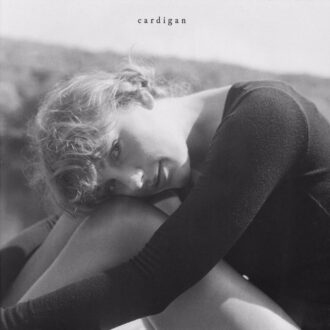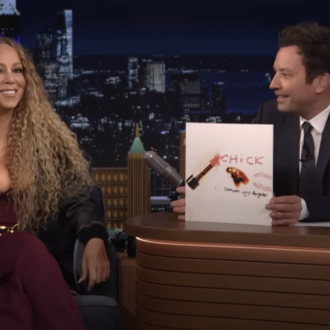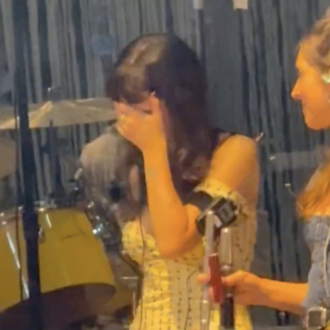Chicago Underground Duo Return, Having Never Really Left

Mikel Patrick Avery
Almost 30 years ago, a new sound began bubbling up in small venues around Chicago — jazz clubs sometimes, but punk clubs and arts centers and other less defined spaces too. Cornet player Rob Mazurek was one of a small coterie of players, some of whom were members of the dubby “post-rock” (remember when that was a thing to aspire to be?) group Tortoise, and others who were experimenting in other ways, but all of whose music was blurring and erasing the boundaries between jazz, rock, electronic music, modern composition and improvisation.
Mazurek hasn’t lived in Chicago for years, but he still calls many of his projects the Chicago Underground… be it Duo, Trio, Quartet, or Orchestra, and being from the city clearly means a lot to him as an artist. “Whenever anyone [asks about] that, I bring their attention to the Art Ensemble Of Chicago,” he says. “They lived there for a very short amount of time and they went all over the place and never lived in Chicago again, but when you listen those early Chuck Nessa recordings in the basement of whoever’s house? I remember those glorious recordings like Sound, Roscoe Mitchell’s first record, which for me is like the Holy Grail of everything… they all came from there.”
“It was the place where we got our bearings, and tried a lot of things, and experienced people who were into different kinds of music, too,” he adds. “Who weren’t just into one type of thing… we were like, We’re gonna do this, we’re open to all kinds of things, basically, because all the people we were hanging out with were people who had record collections of everything, whether it’s the guys from Tortoise or John McEntire or [Jeff] Parker or myself or whatever, being introduced not only to what Roscoe [Mitchell] or the Art Ensemble or Fred Anderson were doing but also to all the great music we were listening to at the time… searching for a way to put things together.”
Drummer Chad Taylor is eight years Mazurek’s junior, but they’ve been playing together since the late ’80s. “I moved to Chicago in 1983 from Tempe, Arizona when I was 10 years old,” Taylor tells me. “I remember seeing this guy with a strange-looking suitcase walking [past] our playground a couple times a week. Five years later, I wound up playing a gig with the bassist Dennis Carroll at a place called Sheffield’s. To my surprise, the guy with that peculiar case was also on the gig and inside of the case was a cornet. That was the first time we played together.”
The two worked together around the city for a couple of years, but then Taylor headed to New York to study at the New School. When he returned, Mazurek and guitarist Jeff Parker were starting what they called the Chicago Underground Sessions on Sunday afternoons at the Green Mill Cocktail Lounge, one of the city’s legendary jazz clubs. “That’s where Chad got pulled into that,” Mazurek says. “He became one of the many drummers that we were using… but when Chad came into the fold, that’s when Chicago Underground started, so that would probably be like ’94.”
Mazurek, Taylor and various friends and interested parties began to record for two key Chicago indie labels. The Chicago Underground Trio, with bassist Noel Kupersmith (and Parker as a frequent guest), signed to Delmark, a straightforward jazz and blues label that had released important early work by Anthony Braxton, Roscoe Mitchell, Muhal Richard Abrams, and others. The Trio’s albums were compositionally adventurous, but recognizably jazz.
The Chicago Underground Duo was a whole other thing. Mazurek and Parker, who by 1998 was also a member of Tortoise, formed Isotope 217 with bassist Matt Lux and Tortoise drummer John Herndon. That group signed to Thrill Jockey, and the label’s founder expressed an interest in Mazurek’s other work. “When Bettina [Richards] over at Thrill Jockey said, ‘Oh, we want a Duo record,’ I was like, ‘Alright.’ I almost really didn’t think of that. But when when she offered that, I said, ‘That seems like a very good idea.'”
Beginning with their debut release, 12° Of Freedom, Mazurek was interested in exploring the studio, transforming their duo performances with electronic effects and recording tricks. Taylor was not so easily won over.
“When Rob first approached me about incorporating electronics into our music, I was like, ‘No.’ Actually, it was more like ‘Hell no!'” he says. “I hated the idea of playing to click tracks, in-ear headphones, and the idea of having to sync up with a computer or sequencer was unappealing. I also wasn’t fond of manipulating the sound of acoustic instruments. But Rob kept at it, and eventually I cracked. To my surprise, not only did I like it, I loved it. I realized that I didn’t have to use a click track and I didn’t have to sync up perfectly to the synthesizers, and it was actually the tension that this created [that] what made the music interesting. I see my role as navigating the tension between human and music technologies.”
That tension is what gives the Chicago Underground Duo’s music its beauty, and it’s all over their eight albums to date, including the brand-new Hyperglyph, their first for International Anthem after two on Northern Spy and five on Thrill Jockey. The album opens with “Click Song,” on which Mazurek blows a nasal, mesmerizing line that’s like a cross between a parade band and the Master Musicians of Jajouka. Behind him, Taylor pounds out a massive avalanche of rhythm, sounding like a whole Brazilian samba school and then adding smaller, bell-like percussion that leaps out of the mix. Listening to the new music, it’s incredible that they haven’t made a Duo album in over a decade.
They’ve never stopped playing together, of course — Taylor is also in Mazurek’s Exploding Star Orchestra, and the Chicago Underground Quartet (with Parker and keyboardist Josh Johnson) made an album in 2020. But Taylor is also in James Brandon Lewis’ quartet, was part of the late Jaimie Branch’s Fly Or Die band, and leads the University of Pittsburgh’s Jazz Studies Program.
“I think we just got basically busy doing other things,” Mazurek says. “We’re like, has it really been 11 years? That’s crazy, because it really feels like yesterday.” He dates the current resumption of activities to a live reunion. “We played a concert in Italy like two years ago and really had such a great time again, you know? No rehearsal, no anything, not even a word spoken. We just did this festival. Stepped on stage, I had certain samples ready to go from various things, and it just flowed so beautifully, it was so powerful that we were like, ‘What just happened?’ This particular thing just had a lot of really beautiful energy to it. And after that happened, we thought, ‘You know, we haven’t made a record in a while.'” Both Mazurek and Taylor had existing relationships with the most important Chicago jazz label of the last decade, International Anthem, so the decision to make the album for them was an easy one.
Most of the pieces on Hyperglyph are quite concise; there’s an initial melodic statement, a rhythmic bed, and as soon as the idea seems to have exhausted itself, it’s over. Mazurek says, “For the records, we like to be as concise as possible and also as compact as possible, maybe because of this punk rock background, but also because… it seems like we get a little flak sometimes with people criticizing the music, that sometimes ideas aren’t developed and then you never hear the the eight-minute solo or [us] really digging into the idea of extended improvisations on the thing. But making that actual song is the improvisation, you know what I’m saying?” Indeed; when studio process and in-the-moment creative inspiration are the focus, the results are as short or as long as they need to be.
The exception, on this album, is the three-part, 13-minute “Egyptian Suite” that takes up most of the record’s second half. The first movement is built around a piccolo trumpet melody from Mazurek over a brilliantly head-spinning rhythm from Taylor.
The drummer tells me, “I’ve always had an interest in African rhythms, primarily because Ed Blackwell was one of the first jazz drummers I started checking out. Instead of transcribing what Ed Blackwell was playing, I started transcribing a lot of traditional African drum ensembles and figuring out my own way of how to interpret them on the drum set.” Indeed, the rhythm on “Egyptian Suite: Part 1 – The Architect” is an incredible amalgam of African polyrhythms and Max Roach-esque swing, with Mazurek repeating a single phrase over and over.
“It was an improvisation based on just that one phrase and then I came up spontaneously with those different sections and it just worked perfectly,” Mazurek says.
The second section, “Triangulation Of Light,” is much more spacious and moody; Taylor is bowing his cymbals as Mazurek emits long tones that harmonize with the metallic groans. That, in turn, leads into the third and final section, “Architectonics Of Time,” which starts out as a full-on drum solo before Mazurek enters at the halfway mark, blowing fierce fanfares over Taylor’s thunderous, unceasing battery.
Hyperglyph is a major artistic statement that still manages to sound tossed-off at times, in the best possible way. Its creators blend stunning instrumental technique — they’re absolute masters — with a love of distortion and weird noises. Almost 40 years since their first encounter onstage at the Green Mill, Rob Mazurek and Chad Taylor are still finding ways to surprise each other, and listeners.
TAKE 10
John Zorn & Dave Lombardo - "Hail And Thunder"
Back at the turn of the century, John Zorn formed a short-lived group called Bladerunner, with guitarist Fred Frith, bassist Bill Laswell, and then-former Slayer drummer Dave Lombardo. I saw them perform at a jazz festival in Manhattan, co-billed with Boredoms; at the end of their set, which was already thunderously loud, Eye Yamantaka came out to scream along with Zorn. The saxophonist and drummer have reunited several times since, with various other collaborators, and Lombardo has often credited Zorn with drawing him into new creative arenas even in his own work. This duo recording is both instantly familiar — as a saxophonist, Zorn has several trademark licks and tricks, all deployed here — and at the same time surprising. Those expecting full-on heavy metal thunder from Lombardo will get more swing and tribal rhythms than they anticipate, but it all works beautifully. These two really know each other well at this point. (From Memories, Dreams And Reflections, out now via Tzadik.)
Joe Farnsworth - "You Already Know"
Drummer Joe Farnsworth is an old-school swinger whose name is known to hardcore jazz fans but not really outside the club scene. That said, if you want to nominate someone who’s absolutely doing the work in the way players like Billy Higgins and Art Blakey did, Farnsworth is a good pick. On this album, he’s put together a band full of players younger than himself, serving as mentor and anchor. The tunes, mostly written by the players, have an old-school hard bop feel; this could easily have been a Blue Note release from the mid ’60s. “You Already Know” is written by pianist Emmet Cohen, and after Farnsworth’s opening barrage, the horns — Jeremy Pelt on trumpet, Sarah Hanahan on alto sax — come flying in, bolstered by Joel Ross’s vibes, Yasushi Nakamura’s bass, and an absolutely unstoppable big beat. Cohen gets the first solo, naturally, but everyone steps up and delivers. (From The Big Room, out now via Smoke Sessions.)
Art Hirahara - "Peace Unknown"
Pianist Art Hirahara, bassist Boris Kozlov, and drummer Rudy Royston have worked together steadily for a while now, on Hirahara’s albums for Posi-Tone and backing various horn players for the label as well. This new album features the largest ensemble the pianist has ever led, a septet with four horns: trumpeter Alex Sipiagin, tenor saxophonist Diego Rivera, alto saxophonist Patrick Cornelius, and trombonist Michael Dease. The opening title track is one of those shimmering fanfare-like pieces you often get in the spiritual jazz genre, but Hirahara’s never been one for that type of thing before now; he’s usually a post-bop player with a strong compositional voice. This is almost like someone tried to rework John Coltrane’s Ascension as a love ballad; the horns are all crying out at once as the piano ripples and swells behind them and Royston attacks the kit, switching between cymbal washes and outbursts of thunder. (From Peace Unknown, out now via Posi-Tone.)
Jason Charos - "The Crown"
https://tidal.com/browse/track/448705418?u
Trumpeter Jason Charos is only 25, but he’s already making a name for himself and playing to sizable audiences as a member of — and arranger for — Grammy-winning vocalist Samara Joy’s band. This album features several other members of that group: alto saxophonist David Mason, tenor saxophonist Kendric McCallister, and pianist Connor Rohrer. They’re joined by bassist Carlo De Rosa and drummer Ludwig Afonso. Dafnis Prieto, a brilliant Latin jazz percussionist and composer who taught Charos at the Frost School of Music in Florida, guests on “The Crown,” the track featured here. It’s an intricate and polyrhythmic piece on which all the horns perform complex, rippling flourishes as the drums clatter and crash, before settling into a subtle groove that seems to come at you from all directions at once. (From Opening Statement, out 8/22 via Hollistic Musicworks.)
Pino Palladino & Blake Mills - "Taka"
Bassist Pino Palladino and guitarist Blake Mills have been collaborating for a while; That Wasn’t A Dream is their second album for Impulse!, following 2021’s Notes With Attachments. They’re joined by drummer Chris Dave and saxophonist Sam Gendel, but this is in no way a traditional jazz quartet record. Each of these men is far too attached to technology and sonic trickery for that. The video for “Taka” is pretty deceptive, because Gendel’s not in it and there’s no way Mills is making all those weird synth-y/flute-y sounds on a guitar, I don’t care what his pedalboard looks like. In any case, the track is a hazy, somewhat flickery groove that starts as one thing and ends as something else, with some sideways leaps into hard James Brown-ish funk along the way. The album is multifaceted and mesmerizing, and also includes a nearly 14-minute track, “Heat Sink.” It’ll set you adrift. (From That Wasn’t A Dream, out now via Impulse!)
Rodrigo Amado/Chris Corsano - "The Cry"
Saxophonist Rodrigo Amado and drummer Chris Corsano have a creative relationship that goes back at least a decade. Their first encounter was the 2015 quartet disc This Is Our Language, featuring Joe McPhee on pocket trumpet and alto sax and Kent Kessler on bass. That group released two more albums in 2018 and 2021, and in 2019, Amado and Corsano released their first duo disc, No Place To Fall. This album actually predates most of that work; it was recorded live in Lisbon in 2016. Amado, like Ivo Perelman, is a freely improvising saxophonist capable of reaching the limits of the tenor saxophone’s range, but also/always possessed of a fundamental lyricism, even romanticism. Corsano is comfortable with any kind of improvised music; I’ve heard him with out jazz players, with free-form psych warriors Sunburned Hand Of The Man, and even backing Jandek. This is intense but joyful music. (From The Healing, out now via European Echoes.)
Jimmy Greene - "As We Are Now"
Sadly, saxophonist Jimmy Greene is better known for a crushing personal tragedy than for his music; his daughter, Ana Márquez-Greene, was murdered in the Sandy Hook Elementary School shootings in 2012. That’s something that swerves your whole life in a new and unwelcome direction. He’s spent the subsequent years transforming his and his family’s pain into art, and the new album is a meditation on resilience and survival, while providing plenty of room for joy and faith. On the title piece, the ensemble — pianist Aaron Goldberg, guitarist Mike Moreno, Hammond organ player Shedrick Mitchell, bassist Dezron Douglas, drummer Jonathan Barber and percussionist Rogerio Boccato — lay down a simple, spiritual melody, occasionally accompanied by spoken phrases from Greene and his wife, before he takes flight with a lyrical and passionate solo. This is jazz as pure emotional communication, and the message it carries only makes it more powerful. May it bring him some peace. (From As We Are Now, out now via Greene Music Works.)
Ami Taf Ra - "The Prophet"
Ami Taf Ra is a North African singer-songwriter based in LA, where she’s cultivated strong ties to the Leimert Park arts community and Kamasi Washington in particular. He produced this album, and he and his crew of musicians — trombonist Ryan Porter, keyboardists Brandon Coleman and Cameron Graves, bassist Miles Mosley, drummers Tony Austin and Ronald Bruner Jr., and others — all perform on it. The music is a mix of jazz, funk, and North African rhythms and melodies, and Ra’s poetic lyrics are delivered in a serene yet intense style that’s explicitly drawn from the work of writer Kahlil Gibran, but her voice reminds me of Brazilian singer Flora Purim. “The Prophet” has a loose, swinging backbeat and a lush arrangement that I guess I’d call “Quiet Storm spiritual jazz,” at least until the choir comes sweeping in just before the three-minute mark. The squiggly synths are a nice touch, too. (From The Prophet And The Madman, out 8/22 via Brainfeeder.)
Kassa Overall - "C.R.E.A.M."
Drummer, producer, and beatmaker Kassa Overall is one of the most interesting figures in jazz at the moment. His embrace of hip-hop impacts every aspect of his work, and he’s making it more explicit than ever on his new album, which is almost entirely made up of instrumental versions of classic hip-hop tracks like “Check The Rhime,” “Back That Azz Up,” “Rebirth Of Slick (Cool Like Dat),” and “C.R.E.A.M. (Cash Rules Everything Around Me),” plus a take on Eddie Harris’ frequently sampled “Freedom Jazz Dance.” This live “C.R.E.A.M.” performance video, shot in the Netherlands, features saxophonists Tomoki Sanders — who it must be said looks uncannily like his dad Pharoah — and Emilio Modeste, keyboardist Matt Wong, bassist Junius Paul, and conguero Bendji Allonce. (The album version features acoustic piano.) The congas set it up nicely, and Overall’s beat is gentle, subtly shifting, but always with the boom-bap in abeyance, ready for deployment. (From CREAM, out 9/12 via Warp.)
Linda May Han Oh - "Portal"
It’s been a couple of years since bassist Linda May Han Oh released an album on her own. She’s been busy, though, most notably as part of pianist Vijay Iyer’s trio with drummer Tyshawn Sorey, who’s also featured here. She’s also appeared on albums by Arooj Aftab, saxophonist Ben Wendel, pianist George Colligan and others. Her powerful playing is always immediately recognizable; she has a deep, woody tone and a highly physical approach (live, she often seems to be dancing with the instrument) that make her more of a driving force than a supporting player.
Oh’s own albums usually foreground her compositional and arranging skills. Her 2021 release, Aventurine, was one of the most ambitious records of the decade thus far, combining a chamber jazz ensemble (saxophone, piano, drums and occasional vibraphone) with a string quartet and a five-member vocal ensemble for a collection of pieces that juxtaposed her own music with tunes by Charlie Parker, Bill Evans, and Johann Sebastian Bach, as well as two radical interpretations of traditional Chinese songs. I got to see her workshop some of the music at the Jazz Gallery; it was head-spinning.
Strange Heavens is arguably a return to her beginnings. Her self-released debut album, 2008’s Entry, was a trio date with Ambrose Akinmusire on trumpet and Obed Calvaire on drums. Akinmusire is back here, and like I said above, Sorey is on drums. The three of them, all roughly of the same generation (Oh is the youngest at 40; Akinmusire is 43, Sorey 45), speak the same language, and the compositions — 10 by Oh, plus versions of pianist Geri Allen’s “Skin” and trombonist Melba Liston’s “Just Waiting” — are loose and sketchy enough to give each member of the trio plenty of room to run. Akinmusire isn’t a fire-breathing trumpeter. Though his command of the instrument is total, he allows his phrases to slip and slide, feeling investigatory but always human in a way that recalls both Bill Dixon and Lester Bowie. Sorey, too, is illimitable on his instrument — he brings all the expressiveness of his work as a composer to bear here, as a player.
“Portal” opens the album, and is a statement of purpose. The bass line is an unresolved but repetitive phrase possessed of a twitchy energy; it won’t let you settle into the groove, and even when Oh punctuates it with big yanks of the strings, it seems like the goal is to increase the tension. Sorey provides accents rather than a steady rhythm, and Akinmusire floats above them, a man on his own path. This is how much of the album feels — it’s a collective work, but each person is as responsible as the other two for where the music might go, or choose not to go, at any moment. (From Strange Heavens, out 8/22 via Biophilia.)



